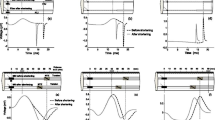Summary
Muscle length influences the contractile properties of muscle in that when muscle is lengthened the relaxation phase of the muscle twitch is prolonged and when muscle is shortened, the relaxation phase is shorter in duration. As a result, the force exerted by active motor units varies with muscle length during voluntary contractions. To determine if motoneuron spike trains were adjusted to accommodate for changes in the contractile properties imposed by shortened and lengthened muscle, motor unit action potentials were recorded from the tibialis anterior muscle at different muscle lengths. Twenty subjects performed isometric ramp contractions at ankle angles of 20° dorsiflexion, neutral between dorsiflexion and plantar flexion, and 30° plantar flexion, which put the tibialis anterior muscle in a shortened, neutral, or lengthened condition, respectively. During isometric contractions where torque increased at 5% MVC/s, motor unit discharge rate at recruitment was greater in shortened muscle than in lengthened muscle (P<0.05). Brief initial interspike intervals (<40 ms) occurred more frequently in shortened muscle than in either neutral length or lengthened muscle. During steady contractions, motor unit discharge rate was greater per unit torque (N.m) in shortened muscle than in neutral length or lengthened muscle (P<0.05). These findings indicate that muscle length does influence the discharge pattern of motor unit spike trains during isometric ramp contractions. Spike trains with higher discharge rates at recruitment in shortened muscle may take advantage of the catch-like properties in muscle and be useful in taking up the slack in the passive elements of the muscle and tendon. During steady submaximal contractions, the higher discharge rate per unit torque (N.m) in shortened muscle is likely due to the decreased peak tension and shorter one-half relaxation time observed in shortened muscle, and may indicate that the tibialis anterior muscle is operating on the steep portion of the length-tension curve when the ankle is fully dorsiflexed.
Similar content being viewed by others
References
Andrew PD (1985) Motor unit activity under low tensions as muscle changes length. Am J Phys Med 64:235–254
Bellemare F, Woods JJ, Johansson R, Bigland-Ritchie B (1983) Motor-unit discharge rates in maximal voluntary contractions of three human muscles. J Neurophysiol 50:1380–1392
Bigland-Ritchie B, Johansson R, Lippold OCJ, Smith S, Woods JJ (1983) Changes in motoneurone firing rates during sustained maximal voluntary contractions. J Physiol 340:335–346
Bigland-Ritchie BR, Dawson NJ, Johansson RS, Lippold OCJ (1986) Reflex origin for the slowing of motoneurone firing rates in fatique of human voluntary contractions. J Physiol 379:451–459
Binder-Macleod SA, Clamann HP (1989) Force output of cat motor units stimulated with trains of linearly varying frequency. J Neurophysiol 61:208–217
Brunnstrom S (1966) Clinical kinesiology, 2nd edn. FA Davis Company, Philadelphia
Burke RE, Rudomin P, Zajac FE (1970) Catch property in single mammalian motor units. Science 168:122–124
Burke RE, Rudomin P, Zajac FE (1976) The effect of activation history on tension production by individual muscle units. Brain Res 109:515–529
Clamann HP (1970) Activity of single motor units during isometric tension. Neurology 20:254–260
Clamann HP, Lamb RL (1976) A simple circuit for filtering single unit action potentials from electrograms. Physiol Behav 17:149–151
Enoka RM, Robinson GA, Kossev AR (1988) A stable, selective electrode for recording single motor unit potentials in humans. Exp Neurol 99:761–764
Finocchio DV, Luschei ES (1985) Active length-tension characteristics of naturally activated muscle: measurement and implications. In: Titze IR, Scherer RC (eds) Vocal fold physiology. Denver Center for the Performing Arts, Denver, pp 283–291
Herring SW, Grimm AF, Grimm BR (1984) Regulation of sarcomere number in skeletal muscle: a comparison of hypotheses. Muscle Nerve 7:161–173
Kato M, Murakami S, Yasuda K (1985) Behavior of single motor units of human tibialis anterior muscle during voluntary shortening contraction under constant load torque. Exp Neurol 90:238–253
Marsh E, Sale D, McComas AJ, Quinlan J (1981) Influence of joint position on ankle dorsiflexion in humans. J Appl Physiol:160–167
Miles TS, Nordstrom MA, Turker KS (1986) Length-related changes in activation threshold and wave form of motor units in human masseter muscle. J Physiol 370:457–465
Milner-Brown HS, Stein RB, Yemm R (1973) Changes in firing rate of human motor units during linearly changing voluntary contraction. J Physiol 230:371–390
Nashner LM (1976) Adapting reflexes controlling the human posture. Exp Brain Res 26:59–72
Nelson RM, Soderberg GL (1983) Laser etched bifilar fine wire electrode for skeletal muscle motor unit recording. Electroencephal Clin Neurophysiol 55:238–239
Partridge LD, Benton LS (1981) Muscle, the motor. In: Brooks VB (ed) Handbook of physiology, Sect I. The nervous system, Vol II. Motor control, Part 1. Am Physiol Soc, Bethesda MD, pp 43–106
Person RS, Kudina LP (1972) Discharge frequency and discharge pattern of human motor units during voluntary contraction of muscle. Electroencephal Clin Neurophysiol 32:471–483
Rack PMH, Westbury DR (1969) The effects of length and stimulus rate on tension in the isometric cat soleus muscle. J Physiol 204:443–460
Stein RB, Parmiggiani F (1979) Optimal motor patterns for activating mammalian muscle. Brain Res 175:372–376
Sutherland DH, Olshen R, Cooper BA, Woo SLY (1980) The development of mature gait. J Bone Joint Surg 62A:336–353
Taniji J, Kato M (1973) Firing rate of individual motor units in voluntary contraction of abductor digiti minimi muscle in man. Exp Neurol 40:771–783
Tax AAM, Denier van der Gon JJ, Gielen CCAM, Kleyne M (1990) Differences in central control of m. biceps brachii in movement tasks and force tasks. Exp Brain Res 79:138–142
Wickiewicz TL, Roy RR, Powell PL, Edgerton VR (1983) Muscle architecture of the human lower limb. Clin Ortho Rel Res 179:275–283
Zajac FE, Young JL (1980) Properties of stimulus trains producing maximum tension-time area per pulse from single motor units in medial gastrocnemius muscle of the cat. J Neurophysiol 43:1206–1220
Author information
Authors and Affiliations
Rights and permissions
About this article
Cite this article
Vander Linden, D.W., Kukulka, C.G. & Soderberg, G.L. The effect of muscle length on motor unit discharge characteristics in human tibialis anterior muscle. Exp Brain Res 84, 210–218 (1991). https://doi.org/10.1007/BF00231776
Received:
Accepted:
Issue Date:
DOI: https://doi.org/10.1007/BF00231776




